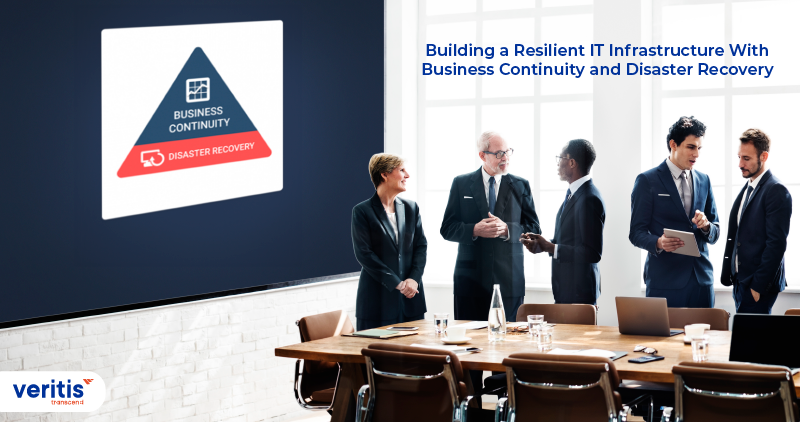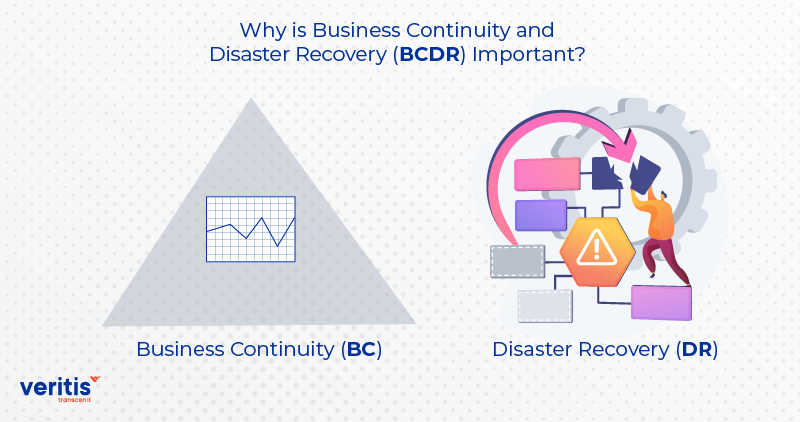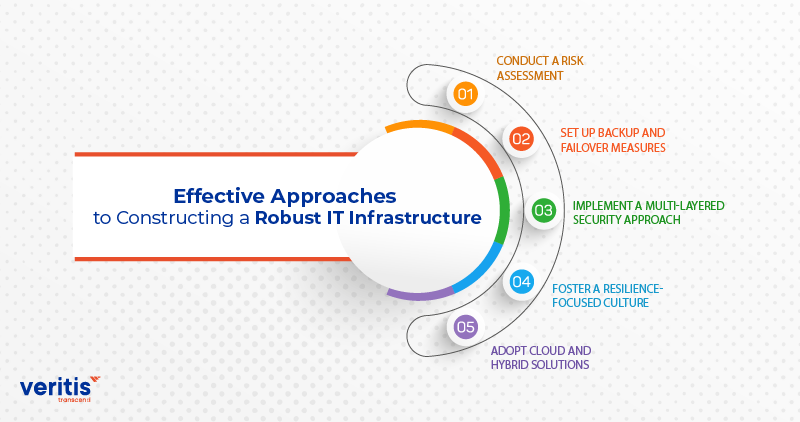
A robust and dependable IT system is essential in today’s fast-changing business world. If you’re the Chief Information Officer (CIO), it’s your job to create and take care of this system. It should handle problems, adjust to changes, and help your organization achieve its goals.
Business Continuity and Disaster Recovery (BCDR) planning involves creating strategies, policies, and procedures to help an organization respond, adapt, keep working, and recover when something terrible happens.
Business continuity means keeping things going as usual when things aren’t going well. Disaster recovery is fixing technology and systems quickly after a problem. Both are important for making sure an organization can keep working.
BCDR is even more critical because organizations face many problems that can’t always be avoided. But with a good plan for disaster recovery and business continuity, an organization can keep running through all kinds of issues. This includes power cuts, system issues, natural disasters, and supply chain issues.
What is a Business Continuity Plan and Disaster Recovery?
An organization’s ability to keep working when things go wrong depends on two processes: Business Continuity (BC) and Disaster Recovery (DR). BCDR aims to ensure that the organization can return to normal if something unexpected happens. These processes also help keep significant data disaster recovery safe and reduce the chances of big problems, which can protect and even make the organization look better.
Using the BCDR highlights the growing awareness that business and technology leaders should collaborate closely. When it is planning for how to respond to incidents, this is more effective than creating separate plans in isolation.
Useful link: 8 Best Business Continuity Management Software Solutions
Why is Business Continuity and Disaster Recovery (BCDR) Important?

The primary role of BCDR is to minimize the impact of outages and disruptions on business operations. These practices are instrumental in helping an organization recover swiftly after issues arise. Reducing the chances of data loss, reputation damage, and operational disruptions while minimizing the occurrence of emergencies.
Some businesses may already have a foundation in DR within their IT departments for individual systems. BCDR encompasses a broader spectrum. It includes crisis management, employee safety, and alternative work arrangements.
Implementing a comprehensive BCDR approach demands meticulous planning and preparation. BCDR professionals play a vital role in helping an organization formulate a strategy to achieve resilience. This intricate process involves conducting a business impact analysis (BIA) and risk assessment, crafting BCDR plans, conducting tests and exercises, and providing training.
Central to an effective BCDR strategy are planning documents. All these documents not only aid in resource management. But it also offers crucial information such as employee contacts, emergency procedures, vendor lists, instructions for conducting tests, and equipment inventories. And technical diagrams of systems and networks.
The Interplay of Business Continuity and Disaster Recovery
Business continuity planning and disaster recovery policy are like partners that help a business stay safe and running smoothly. Business continuity services ensure that a business can keep doing its essential tasks, like talking to customers and getting work done. It’s important even if something terrible, like a disaster, happens.
If something goes wrong, disaster recovery and business continuity focus on fixing the technical stuff, like computers and data. Its job is to get things back to normal quickly. These two plans work together. Business continuity services need a disaster recovery policy to ensure everything stays on track, and disaster recovery helps business continuity strategy by fixing technical problems quickly. Ultimately, these plans help businesses stay safe, keep working well, and get back up and running if something unexpected happens.
Useful link: What is a Disaster Recovery Plan? How Confident Are You in Implementing it?
Business Continuity vs Disaster Recovery Plan
The table below illustrates the differences between business continuity and IT disaster recovery plans. It addresses similar aspects but from a comprehensive business perspective.
| Business Continuity Plan | IT Disaster Recovery Plan |
| Designed to maintain business operations through and after a crisis, protecting financial stability and reputation | Focused on minimizing harm to IT assets during a disaster and achieving rapid and full recovery |
| Catalog of essential business assets, including employees, suppliers, vehicles, and buildings, among others | List of IT assets, such as network equipment, servers, endpoints, and more |
| Assessment of the impact of threats on business operations | Evaluation of threats impacting IT infrastructure |
| Incorporates a continuous proactive element for disaster prevention and preparedness | Primarily centered on reactive actions in the event of a disaster |
| This can involve moving operations to a different location, using alternative technology, or changing business processes. | This involves recovering data, restoring IT systems, and rebuilding physical infrastructure |
| To ensure business continuity during a disruption | To bring the business back to regular operations following a disaster |
| Covers all aspects of the business, including people, processes, and technology | Focuses on critical systems and data |
| It starts before a disaster occurs and continues during and after the disaster | It starts after a disaster occurs and ends when the business is restored to normal operations |
| Regularly tested to ensure it is up-to-date and effective | Tested less frequently than a business continuity plan |
| Cost can be expensive to develop and maintain | Cost can be less expensive than a business continuity plan |
What Elements Should be Part of a Disaster Recovery Plan?

A disaster recovery planning checklist is like a to-do list that helps ensure everything is ready when things go wrong. Let’s break down its importance:
1) Set Recovery Goals (RTO and RPO)
Set each important system or app’s recovery time (RTO) and recovery point objective (RPO). These define the longest acceptable downtime and data loss limits, guiding recovery. Prioritize systems and apps as RTO and RPO differ for each.
2) Recognize the Involved Stakeholders
Recognize everyone involved in disaster recovery solutions. This includes IT teams, business units, senior management, and outside vendors. Ensure clear communication of their roles for effective collaboration during crises.
3) Create Communication Channels
Create robust communication methods for smooth disaster communication. This involves choosing primary and backup communication modes and making emergency contact lists. And setting rules for reporting and escalating incidents.
4) Gather All Infrastructure Documentation
Collect detailed records of your organization’s infrastructure. This includes network diagrams, system configurations, software licenses, and vendor contacts. This information is crucial for adequate recovery.
5) Select the Appropriate Technology
Choose the technologies and tools that match your recovery goals and your organization’s unique requirements. This might involve selecting backup and replication solutions, virtualization technologies, cloud services, and data disaster recovery software.
Useful link: Business Continuity Planning: Steps To ‘Restart’ Your Stalled Operations!
Effective Approaches to Constructing a Robust IT Infrastructure

1) Conduct a Risk Assessment
Find IT infrastructure threats and vulnerabilities and focus on pressing issues. And keep your risk assessment up-to-date to adapt to evolving risks.
2) Set Up Backup and Failover Measures
Set up backup systems, data copies, and failover procedures to guarantee critical operations persist during disruptions. Consistently test these safeguards for optimal performance.
3) Implement a Multi-Layered Security Approach
Establish a thorough security approach with multiple layers—encompassing firewalls, intrusion detection and prevention systems, encryption, and routine security audits.
4) Foster a Resilience-Focused Culture
Promote a culture of resilience within your organization by investing in training, resources, and support for your employees. This means providing them with the knowledge and tools they need to identify and manage risks proactively.
5) Adopt Cloud and Hybrid Solutions
Utilize cloud and hybrid IT solutions to enhance the flexibility and resilience of your IT infrastructure. These options offer added redundancy, scalability, and cost-efficiency.
Useful link: Disaster Recovery’s Strategic Approach to Organizational Growth
Conclusion
By following these essential steps, CIOs can create a robust IT setup that ensures business operations continue smoothly, reduces risks, and boosts efficiency. Investing in a reliable IT system helps your organization stay flexible, competitive, and ready for unexpected disruptions.
A resilient IT infrastructure and a competitive advantage are necessary in the ever-evolving business and technology landscape. It’s the key to maintaining operational efficiency, mitigating risks, and ensuring business continuity, even when facing unforeseen challenges. Building and managing such an infrastructure requires careful planning, comprehensive strategies, and the right partner.
Veritis, a distinguished Stevie and Globee Business Awards recipient, brings expertise and excellence to your IT services. With a focus on innovation and a commitment to delivering top-tier solutions, Veritis is your trusted ally in navigating the complexities of the digital age.
Got Questions? Schedule A Call
Additional Resources:
- How to Plan an Effective Cloud Disaster Recovery Strategy?
- Disaster Recovery’s Strategic Approach to Organizational Growth
- Disaster Recovery Services for Universities
- Cloud-Based Disaster Recovery Plan (Infographic)
- AWS – Perfect Choice for Disaster Recovery
- Disaster Recovery – No More A Budgetary Constraint with Cloud
- Hybrid Cloud Vs Multi Cloud: What’s the Difference!